Montmort - Petit village avec beaucoup d'histoire
Cette cache vous amènera au petit village de Montmort et vous raconte une partie de son histoire.
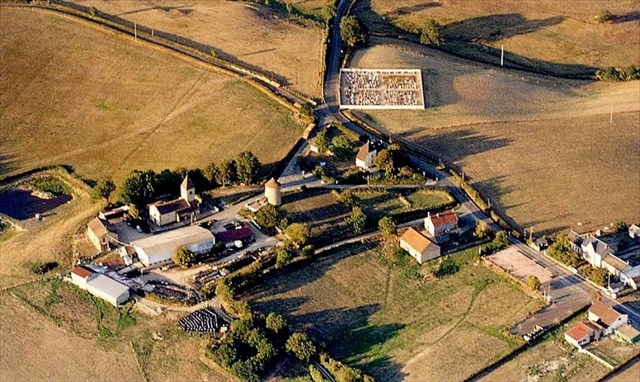
La première fois que l'on entend parler de Montmort, c'est à la bataille de César contre les Helvètes, à proximité du hameau d'Armecy en 58 av. J.C. Très probablement des populations s'étaient implantés autour de Montmort depuis, notamment en raison de son bon endroit stratégique sur le mont, à partir duquel vous pouvez arpenter les vallées environnantes.
Dans les archives de Macon existent des documents qui montrent que de nombreuses livraisons de pierre des carrières du Morvan et de l'Auvergne ont été portées au Val d'Arroux, à partir d'environ 970. Le seul bâtiment de grande taille dans cette zone qui a été tracée à partir de ce moment est le château fort de Montmort, datant de la seconde moitié du 10ème siècle. A cette époque, Montmort était située juste à la frontière de la Francie occidentale et du royaume de Bourgogne. On suppose que ce château fort a été d'une grande importance et que, à côté du seigneur, vécurent environ 15 chevaliers ainsi leur familles, leur soldats et tout leur cortèges.

En 1370, le propriétaire du château était Jean-François de Montmort (héritier de Monsieur le Président du Parlement de Bourgogne, Loppin de Montmort), et «cette terre appartenait, en 1418, à un Renaud de Montmort, écuyer banneret" (Statistique du Département de Saône-et-Loire, de 1838 par Camille Ragut). Au milieu du XVIIIe siècle, la seigneurie de Montmort appartenait au marquis de La Boulaye, Claude-Bernard Loppin de Montmort, sous-lieutenant au régiment des Cravates. A l'époque récente, figurait parmi les propriétaires, Henri Schneider, maître de forges au Creusot.
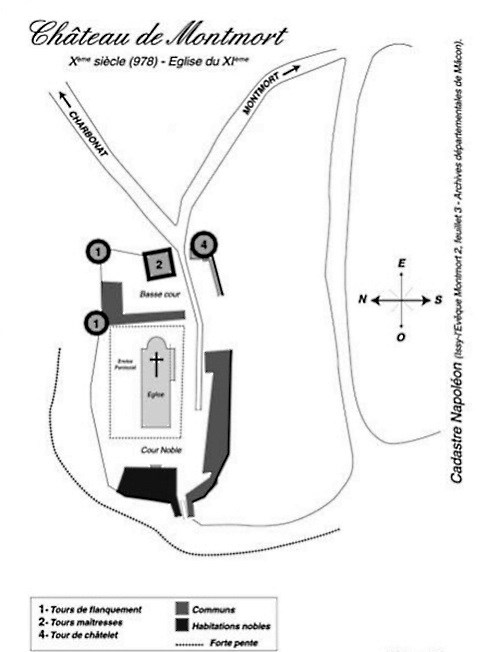
Le château est partiellement détruit au 14eme siècle. Au 18ème siècle, les propriétaires du château ont commencé à détruire des bâtiments, des murs et des tours. Mais au cours du relevé cadastral de 1838, il subsistait suffisamment de vestiges impressionnants, qui permirent de reconstituer un plan.

Aujourd'hui une seule tour (N 46° 44.253 E 4° 05.393) et l'église nous rappellent le château. La tour est marqué numéro 4 sur le plan et utilisée pour être la tour nord-est, à droite au Châtelet. C'est aujourd'hui une propriété privée.
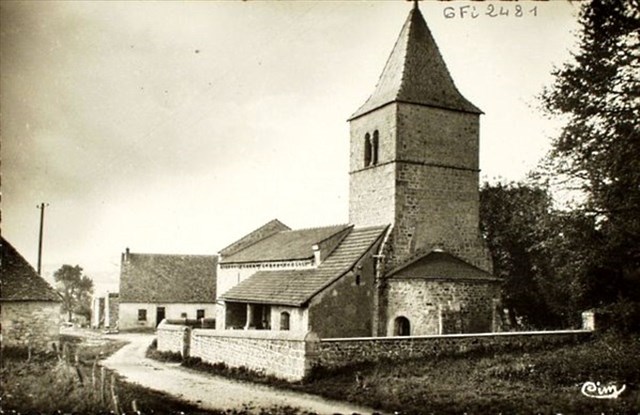
Une partie de l'église (N 46° 44.251 E 4° 05.358), qui est aujourd'hui l'église paroissiale, fût l'ancienne chapelle du château. La première partie de l'église a été construite au 11ème siècle et comprenait le clocher, que vous voyez encore aujourd'hui. L'église a été agrandie au 13ème siècle. La plus grande partie de l'église date encore de cette époque.
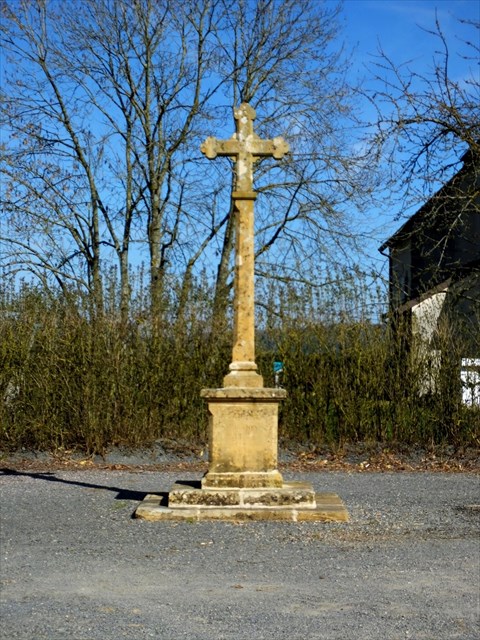
A (N 46° 44.259 E 4° 05.411) vous trouver une ancienne croix en pierre.
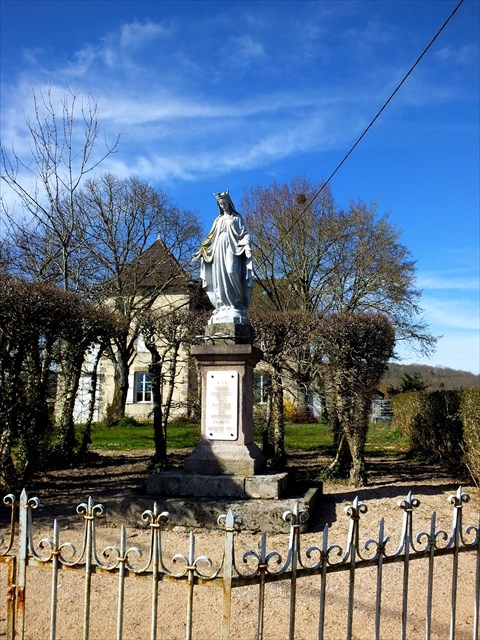
Directement à la cache, vous trouverez la statue de la Vierge Immaculée, placé ici en 1898.
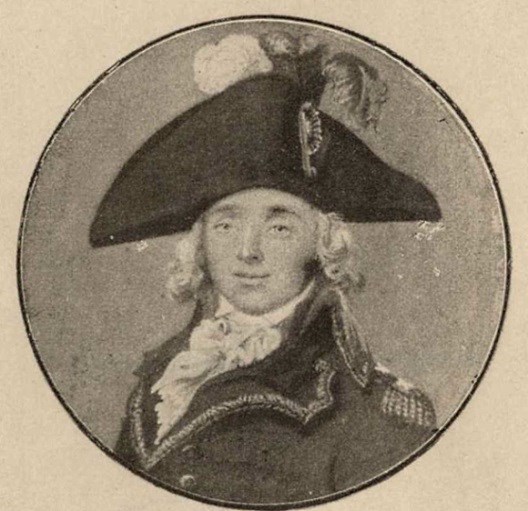
Montmort a aussi un fils célèbre. Antoine Marie Bard, un général français, né le 21 Janvier 1759 à Montmort. De 1778 à 1781 il a servi sous l'ancien régime comme gendarme. Après la Révolution française, en 1789, il rejoint la Garde nationale. Il devient major et commande la garde nationale de Toulon-sur-Arroux en 1791. Il rejoint les bataillons de volontaires et devient lieutenant du régiment d'infanterie du 43e de ligne dont il a fait partie à la bataille de Jemappes. En 1793, il est nommé à la téte du 10e bataillon d'Orléans et ensuite est fait général de brigade le 29 septembre 1793. Commandant de la division de Luçon, en Vendée il prend part aux colonnes infernales et commande les garnisons de Luçon et Chantonnay. Après une blessure au combat, il a dû battre en retraite en 1795. Antoine Marie Bard s'installe à Toulon-sur-Arroux, où il meurt le 9 Novembre 1837.
S'il vous plaît noter: Il s'agit d'un nano "spécial". L'aimant ne peut pas être retiré de l'objet. S'il vous plaît prenez uniquement le conteneur. Dans ce cas, s'il vous plaît assurez-vous que vous ne perdez pas le logbook. Vous avez besoin de patience et de discrétion. Le cache est très public. S'il vous plaît après avoir écrit sur le log, replacez le cache exactement sur l'aimant tel que vous l'avez trouvé. Il est plus facile de prendre le logbook avec une pince à épiler à partir du conteneur.
This cache will take you to the small village of Montmort and tells you a part of its history.
The first time we hear about Montmort is connected with the battle of Caesar against the Helvetii, near the hamlet of Armecy in 58 BC. Probably settlements were located around Montmort ever since, especially because of its good strategic location on the hill, from which you can survey the surrounding valleys.
In the archives of Macon exist documents that show that many deliveries of stone from the quarries of Morvan and Auvergne were brought to the Val d'Arroux, starting around 970. The only large building in this area which has been found until today, is the castle of Montmort, dating to the second half of the 10th century. At this time, Montmort was located just at the border of West Francia and the Kingdom of Burgundy. It is assumed that this castle was of great importance and that here, next to the Lord, lived about 15 knights with their families, their soldiers and all their cortege.
In 1370 the owner of the castle was Jean-François Montmort (heir of the President of the Parliament of Burgundy, Loppin Montmort), and "this land belonged in 1418 to Renaud Montmort..." (Statistique du Département de Saône-et-Loire, 1838 by Camille Ragut.) In the middle of the eighteenth century, the lordship of Montmort belonged to the Marquis de La Boulaye, Claude-Bernard Loppin Montmort, sub-lieutenant in the regiment of Cravates. In more recent times, one of the owners was Henry Schneider, Maître de forges at Le Creusot.
The castle was partially destroyed in the 14th century. In the 18th century, the owners of the castle began to destroy buildings, walls and towers. But during the cadastral survey of 1838, there were still enough impressive remains, which made it possible to reconstruct a plan.
Today one tower (N 46° 44.253 E 4° 05.393) and the church remind us of the castle. The tower is marked number 4 on the plan and used to be the north-east tower, right at the Châtelet. It is now privately owned.
Part of the church (N 46° 44.251 E 4° 05.358), which is now the parish church, was the former chapel of the castle. The first part of the church was built in the 11th century and included the bell tower, which you still can see today. The church was enlarged in the 13th century. The greater part of the church today dates back to this period.
At (N 46° 44.259 E 4° 05.411) you find an ancient stone cross.
Directly at the cache, you will find the statue of the Immaculate Virgin, placed here in 1898.
Montmort also has a famous son. Antoine Marie Bard, a French general, born 21 January 1759 in Montmort. From 1778 to 1781 he served under the former regime as a gendarme. After the French Revolution, in 1789, he joined the National Guard. He became a major in 1791 and commanded the National Guard of Toulon-sur-Arroux. He joined the battalions of volunteers and became a lieutenant of the 43rd line infantry regiment with which he was part of the Battle of Jemappes. In 1793, he was appointed the head of the 10th Battalion of Orleans and then was made brigadier general on September 29, 1793. Commander of the division of Luçon, he took part in the battles of Vendée with the „colonnes infernales“ and commanded the garrisons of Luçon and Chantonnay. After an injury in battle, he had to retreat in 1795. Antoine Marie Bard moved to Toulon-sur-Arroux, where he died on November 9, 1837.
Please note: This is a nano "special". The magnet can not be removed from the object. Please take only the container. While you do that, please make sure you do not lose the logbook . You need patience and discretion. The cache is very public. After writing in the log, please replace the cache exactly on the magnet as you found it. It is easier to take the logbook from the container by using tweezers.
Dieser Cache führt Euch zu dem kleinen Dorf Montmort und erzählt Euch einen Teil seiner Geschichte.
Das erste Mal hören wir von Montmort in Zusammenhang mit der Schlacht von Caesar gegen die Helvetier, in der Nähe der Ortschaft Armecy, 58 v. Chr. Wahrscheinlich existierten seit dem Siedlungen rund um Montmort, vor allem wegen der guten strategischen Lage auf dem Hügel, von dem aus man die umliegenden Täler überblicken kann.
In den Archiven von Macon existieren Dokumente, die zeigen, dass viele Lieferungen von Stein aus den Steinbrüchen vom Morvan und der Auvergne in das Val d'Arroux gebracht wurden, beginnend um 970. Das einzige große Gebäude in diesem Bereich, das bisher gefunden wurde, ist das Schloss von Montmort aus der zweiten Hälfte des 10. Jahrhunderts. Zu dieser Zeit lag Montmort direkt an der Grenze von Westfranken und dem Königreich Burgund. Es wird angenommen, dass dieses Schloss von großer Bedeutung war, und dass hier, neben dem Burgherrn, etwa 15 Ritter mit ihren Familien, ihren Soldaten und ihrem gesamten Gefolge lebten.
Im Jahre 1370 war der Besitzer der Burg Jean-François Montmort (Nachkomme des Präsidenten des Parlaments von Burgund, Loppin Montmort) und "dieses Land gehörte im Jahre 1418 Renaud Montmort ..." (Statistique du Département Saône-et-Loire, 1838 von Camille Ragut.) in der Mitte des achtzehnten Jahrhunderts, gehörte die Herrschaft von Montmort dem Marquis de La Boulaye, Claude-Bernard Loppin Montmort, Unterleutnant im Regiment „Cravates“. In neuerer Zeit, war einer der Eigentümer Henry Schneider, Maître de Forges in Le Creusot.
Die Burg wurde im 14. Jahrhundert teilweise zerstört. Im 18. Jahrhundert begannen die Besitzer der Burg Gebäuden, Mauern und Türme zu zerstören. Aber während der Vermessung von 1838 gab es immer noch ausreichende beeindruckende Überreste, die es ermöglichten, einen Plan zu rekonstruieren.
Heute erinnert uns ein Turm (N 46° 44.253 E 4° 05.393) und die Kirche an die Burg. Der Turm ist mit Nummer 4 auf dem Plan markiert. Er war der Nord-Ost-Turm, direkt am Châtelet. Er ist heute in Privatbesitz.
Ein Teil der Kirche (N 46° 44.251 E 4° 05.358), welche heute als Pfarrkirche von Montmort dient, war die ehemalige Kapelle des Schlosses. Der erste Teil der Kirche wurde im 11. Jahrhundert gebaut und beinhaltet den Glockenturm, den man heute noch sehen kann. Die Kirche wurde im 13. Jahrhundert erweitert. Der grösste Teil der heutigen Kirche stammt aus dieser Zeit.
Bei (N 46° 44.259 E 4° 05.411) findet Ihr ein altes Steinkreuz.
Direkt am Cache, werdet Ihr die Statue der Unbefleckten Jungfrau Maria, hier im Jahr 1898 aufgestellt, finden.
Montmort hat auch einen berühmten Sohn. Antoine Marie Bard, ein französischer General, geboren am 21. Januar 1759 in Montmort. Von 1778 bis 1781, unter dem ehemaligen Regime, war er ein Gendarme. Nach der Französischen Revolution, im Jahre 1789, trat er in die Nationalgarde ein. Er wurde 1791 zum Major ernannt und befahl die Nationalgarde von Toulon-sur-Arroux. Er trat in die Bataillone von Freiwilligen ein und wurde Leutnant des 43. Linien-Infanterie-Regiments, mit dem er ein Teil der Schlacht von Jemappes war. Im Jahre 1793 wurde er zum Leiter des 10. Bataillons von Orleans ernannt und wurde am 29. September 1793 Brigadegeneral. Als Kommandeur der Division von Luçon nahm er in Vendée mit den „colonnes infernales“ an den Schlachten teil und befahl die Garnisonen von Luçon und Chantonnay. Nach einer Kriegsverletzung musste er 1795 in Rente gehen. Antoine Marie Bard zog nach Toulon-sur-Arroux, wo er am 9. November 1837 starb.
Bitte beachten: Dies ist ein Nano "Spezial". Der Magnet kann nicht vom Objekt entfernt werden. Bitte nehmt nur den Container ab. Während Ihr das tut, achtet bitte darauf, das Logbuch nicht zu verlieren. Man braucht Geduld und Diskretion. Der Cache ist sehr öffentlich. Nach dem Eintrag ins Logbuch patziert den Behälter bitte wieder ganau so auf dem Magneten, wie Ihr ihn gefunden habt. Es ist einfacher das Logbuch mit einer Pinzette aus dem Container zu nehmen.